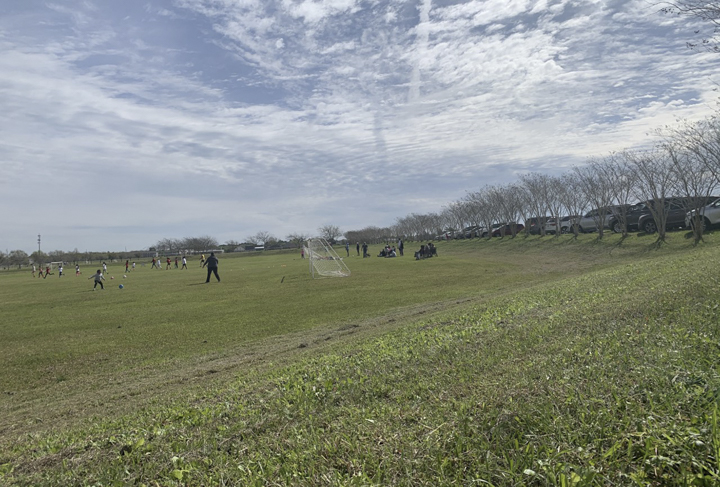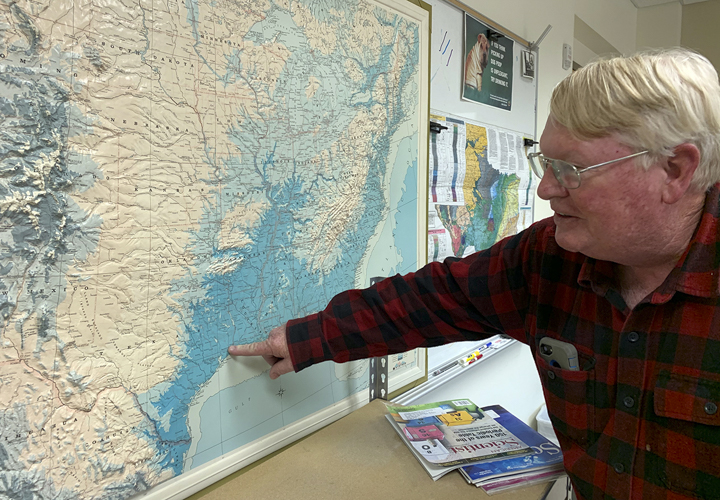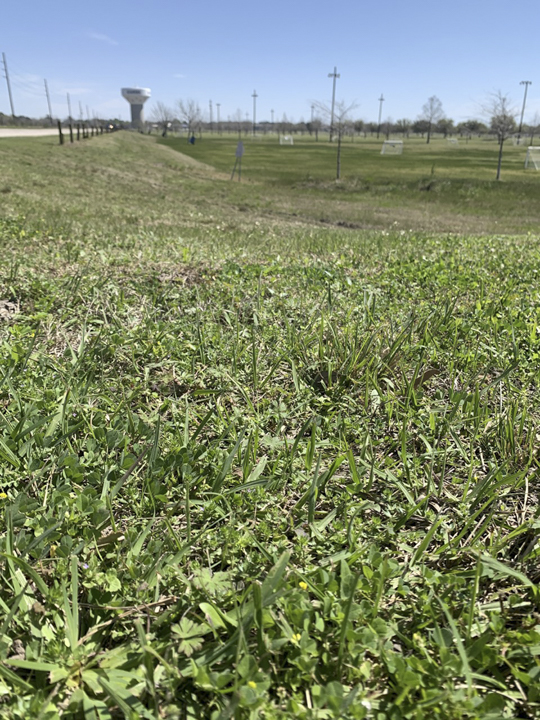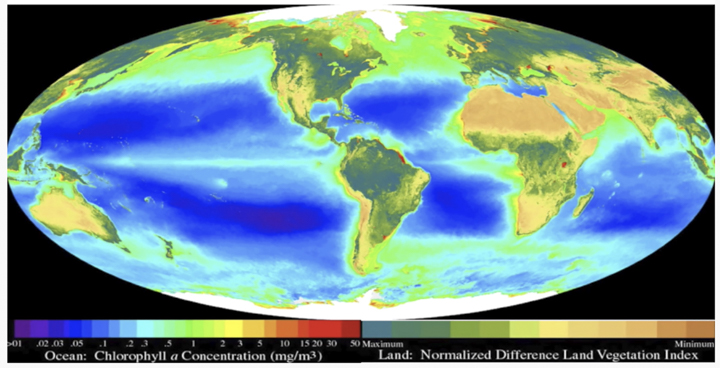Climate change prevention requires community support

“We know from the Hubble Space Telescope there are more than 1 trillion galaxies — each galaxy has on the order of a billion stars and as far as we know, there’s no other place where life exists,” Compton Tucker, senior biospheric scientist for NASA/Goddard Space Flight Center, said during a Feb. 18 presentation on climate change at Lamar University. “Therefore, I feel we should be conservative in how we treat the Earth —in the true sense of the word conservative.”
In Tucker’s presentation, “The Satellite Record of Earth’s Climate: The Late 1970s to Now,” he uses satellite records to show how sea levels have increased, sea ice and glacier ice have decreased, and the energy output from the sun, a common variable cited in climate change debates, has remained consistent since satellite observations began in 1978.
“Sea level data since 1992 (shows) about three and a half millimeter per year increase. This means the Earth is warming,” Tucker said. “And when the Earth warms, two things happen. Water expands and, also, ice melts. So, this increase is due about 50 percent to the thermal expansion of water and 50 percent to the melting of the ice sheets.”
Nearly 4,000 autonomous buoys are scattered across the Earth’s oceans, continuously measuring temperature and salinity, before surfacing and transmitting the data to a satellite that then relays the data to Argo headquarters in California, Tucker said.
“This is how we get information about the temperature in the oceans with depth, and that’s how we’re able to calculate very accurately the thermal expansion — as sea water warms, it expands,” he said.
Jim Westgate, professor emeritus at Lamar University, who previously taught paleontology, meteorology, oceanography, environmental geology and a field camp for earth science majors, said that for Southeast Texans, rising temperatures could mean busier hurricane seasons and a gradually encroaching ocean as sea levels rise.
“People predicted, with global climate change, that we’d get more hurricanes and tropical storms, but they thought if we had more, they might not be as severe,” Westgate said. “But what it’s turned out to be, is we’re getting more and they’re stronger.
“Since 2010, we’ve had five of the busiest hurricane seasons out of the top 20 that are recorded. That goes back to 1851. Since ’69, we’ve had the 10 busiest seasons, but of those 10, five have been since 2010.”
Westgate said that the trend appears to be the new normal. As global warming increases, it will translate to stronger, more frequent storms, and an earlier and longer hurricane season.

“In the 1900s we had three Cat 5s,” Westgate said. “So we got three in a century and already in 20 years, we’ve had several Cat 5s.”
As for what to expect for the 2020 hurricane season, Westgate says there’s still too many variables to attempt a prediction.
“It’s hard to tell,” he says. “Right now, La Niña is ongoing, and that helps to prevent busy seasons.
“We’re watching the surf temperatures off of Sabine Pass. They’re about 10 degrees warmer than they should be. We don’t normally get tropical storms until the Gulf hits 80 degrees, and that averages around June 1. But I think we’re going to start seeing tropical storms forming in late May before too long.”
In 2017, Hurricane Harvey, the wettest tropical storm ever recorded in U.S. history, dumped 60 inches of rain on Southeast Texas. This was followed by Tropical Storm Imelda in September, the fifth wettest tropical storm in the contiguous U.S., with rain totals of more than 43 inches.
As the new century has revealed weather patterns that don’t match the previous one, Westgate said it is important that local governments adapt their infrastructure to the change.
“The soccer fields on Major (Drive) were built about 20 years ago, and they figured that would contain a 15-inch rain, and we’d never get more than 15 inches in a storm,” he said. “Obviously, they need to build two or more of those out there.”

Jefferson County’s Drainage District 6, which covers Beaumont, has build several retention ponds to alleviate flooding. The retention ponds double as soccer fields when they are not needed for flood control.
“Doing that helped us a whole lot with these two big rain events, whereas Vidor got flooded and Port Arthur got flooded, because they haven’t put in the infrastructure of retention ponds like we have,” Westgate said. “That’s another thing Southeast Texas should be pushing for. We should have three soccer field complexes on Major, not just that one.”
The effects of climate change in Southeast Texas aren’t restricted to weather. In Tucker’s talk, he underlined the responsibility humans have to our biotic counterparts (plants, animals, sea life) and the importance of biodiversity.
Coastal erosion is a naturally occurring phenomenon that can be exacerbated overnight by hurricanes. But climate change induced sea level rise would mean that rising oceans slowly spill over areas the closer they are to sea level, Westgate said.
“Right now, projection for 2100, based on today’s rates — which won’t be our rates in the future if we keep putting more CO2 in the system — we may have a two meter, or about six-foot, rise in sea level in the next 80 years.
“Most of Bridge City is at about five feet. So, if we get a six-foot rise, people in Bridge City might care. You drive from campus to Port Arthur, Sabine Lake is about 20 miles and we’re at 20 feet, so every mile you go south, you drop a foot. So that means, if sea level rises six feet, the shoreline will move six miles inland.”
Westgate said students can mitigate the risks of coastal living with awareness and planning.
“If you have a choice of where you’re going to live, be aware of places that have flooded in the past,” he said. “I live at 30 feet. But just west of me, half a mile away, is a creek area, Major runs along a creek there, and a couple of my students flooded there, even though they are only half a mile from 30 feet, which is as high as you can get in Beaumont.”
Westgate advises students who are looking for apartments to be aware of the risks of living on the first floor in flood-prone areas.
On an individual level, Tucker said there are small things we can all do that add up.
“I ride my bike a lot of places,” he said. “I try to minimize my use of fossil fuels, I try to minimize my use of plastic.”
The Texas Commission on Environmental Quality has created Ozone Action Days, where the community is asked to voluntarily help reduce air pollution emissions when weather conditions are expected to contribute to hazardous levels of pollution for the young, old and people with chronic lung disease.
“(On Ozone Action Days) you’re supposed to gas up your car in the evening, cut the grass on a non-ozone action day, don’t go through the drive-thru at McDonald’s — you should just park and go in,” Westgate said.
Tucker said he remains optimistic about the future of the Earth and our climate.
“I think we can solve our problems,” he said. “We have to work together, and we have to do so in a concentrated way.”
Tucker said humans are capable of completing massive goals when properly motivated — citing the Manhattan project, where scientists from around the world organized to build the atomic bomb in less than three years, and John F. Kennedy’s “Let’s Go To The Moon” program, which took only seven years to complete.
“I’m not pessimistic about things,” Tucker said. “I think we can organize, and we can minimize climate change and prevent this part of Texas from being underwater in 40 or 50 years.”
For more information on Ozone Action Days, visit setrpc.org/ozone-action-day.

